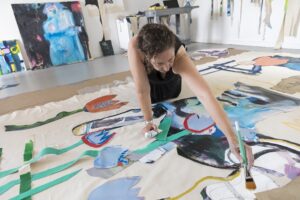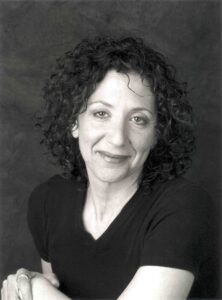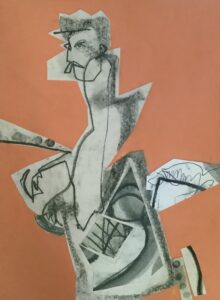In 1976, artist Lee Krasner took scissors to a pile of still-life charcoal and figure drawings from her late-1930s art classes with Provincetown’s Hans Hofmann. She turned the triangular shards into something new: 11 collages grouped as “Eleven Ways to Use the Words to See.”

Nearly 50 years later, that act is the inspiration for a similar transformation. Provincetown artist Laura Shabott has been cutting up her own figure drawings, following Krasner’s parameters of shape and method, and reassembling the pieces into new collages. She’ll create a 50-by-60-inch work of art before a live audience for a Sept. 14 theatrical event titled Lee and Tennessee at the Fine Arts Work Center.

Shabott plays Krasner, whose work over 50 years included portraits, Cubist drawings, and large-scale abstract paintings in addition to collage-assemblage. In a one-time performance the organizers are calling a “harmonic convergence of arts and letters,” Shabott will provide the visual effect of art installation on the Work Center stage while actors John Dennis Anderson and Luke Bosco read scenes by playwright Tennessee Williams.
In the late 1970s, Williams wrote Something Cloudy, Something Clear as a reworking of his 1940 play Parade, about his first summer in Provincetown and falling in love. “Reconfiguring the past for present meaning” is how Lee and Tennessee director David Kaplan, co-founder-curator of the Provincetown Tennessee Williams Theater Festival, describes both artistic efforts referenced in the event.
Living with her own show-inspired project, Shabott knows what it must have felt like for Krasner and Williams: “You don’t often get a chance in life to take your mistakes and create them as new,” she says. “It’s very freeing and refreshing.”
Krasner recognized that she would often first be thought of as artist Jackson Pollock’s widow, says Kaplan, but she was able literally to expand the size of her own art by moving into Pollock’s vast workspace after his death in 1956. Unlike most women of her generation, Kaplan notes, she also had enough money to pursue her vision without worrying about art critics.
“As a person and as a woman, she reconstructed her past to give herself an identity for the future,” says Kaplan, who referenced the 1970s Krasner-Williams parallel in his 2006 book Tennessee Williams in Provincetown. “To create your own persona, knowing that it will outlast what they said about you in the past, is another thing about both Krasner and Williams. They were painting and writing for audiences of the future.”
Lee and Tennessee will include the performance, a reception, and a visit to Shabott’s studio for the project’s FAWC residency. This is the Williams festival tribute to female artists past and present for the Provincetown Art Gallery Association’s Forum 24. That season-long series of events marks the 75th anniversary of the Forum 49 presentations on emerging modern art that experts say changed the history of art in Provincetown and worldwide.
Forum 24 is in part intended to explore the town’s continuing relevance as a creative community, according to co-chair Cid Bolduc. Shabott notes that Lee and Tennessee involves four cultural institutions — including the Berta Walker Art Gallery, where Shabott shows her work — combining to make it happen in a community that still supports the arts.
“I love the mash-up of the words, theater, and art,” Shabott says of the show. “We are still a thriving arts colony even with our challenges, and one of the solutions has been these partnerships with different organizations. We are a unique place.”

Kaplan says he wanted Shabott, who has occasionally acted on local stages, to play Krasner because of the similarity in their collage work. While the initial idea was for Shabott only to create art during the Lee and Tennessee performance, she was inspired enough by Krasner that she’s making 11 pieces, too. “I just fell in love with the whole process,” she says.
Shabott is a studio artist and gallery assistant whose own work has included large-scale pieces with vibrant color and sweeping forms and a series, “I Am Here,” that explores the hand as motif and symbol. She has had various FAWC residencies and as art teacher and lecturer has used Mary Gabriel’s book Ninth Street Women, which focuses on Krasner and four other female artists who revolutionized the modern-art world. Shabott says she has a deep commitment to sharing the history of Provincetown art, and, like Krasner, has been inspired by Hofmann.
Shabott says the focus of Lee and Tennessee — deconstructing and reconstructing to make something new — holds special meaning. “That’s a theme through Lee’s life,” she says, “and mine, too.”
Art and Words Converge
The event: Lee and Tennessee
The time: Saturday, Sept. 14, 4-6 p.m.
The place: Fine Arts Work Center, 24 Pearl St., Provincetown
The cost: $20 at provincetownartgalleryassociation.org/forum-24



